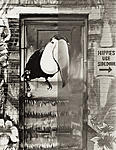Bob,
I’m doing this from a phone so hopefully all goes as I plan
I know you always said you believe using 0 filtration can sometimes cause solarization. I have not found that in my printing. That said my Green exposures usually run 4-6 seconds and are never more than the Blue exposure. I believe many of the negs you get from clients are more dense and may require much more 0 filtration which might well be causing the solarization you are seeing. You know I only print with 0 and 5 and feel very strongly about that.
The phrase “projected thru the negative”. That’s the key to this Flashing technique. Consider the attach photo which shows all 5 exposure on the left side and all 0 exposure on the right side. With the right side 0 exposure, the lightest part on the print comes from the densest area on the negative. So, all the surrounding densities that are slightly less are the mid-tones. So, if we can reduce the amount of 0 filtration that is exposed “above and thru” the negative, by means of Flashing / bringing paper to threshold. The real gain is in the mid-tones which are less dense than the highlights. When the mid-tones “see” less 0 / Green exposure the contrast is increased because they are “less contaminated” with 0 filtration in less dense negative areas.
The way I discovered this technique is because of a failed negative. Check out the link and the story, it also describes a flashing technique with a Blue gel instead of a Green gel.
Cheers.





 Reply With Quote
Reply With Quote


Bookmarks